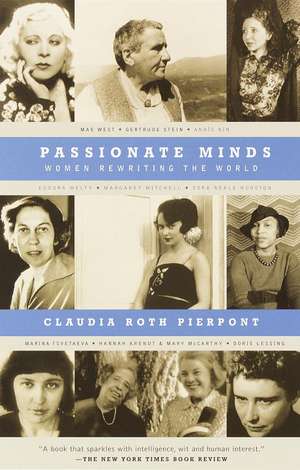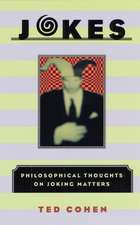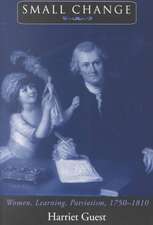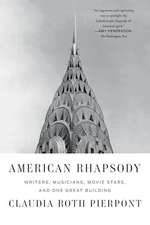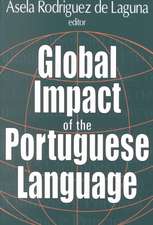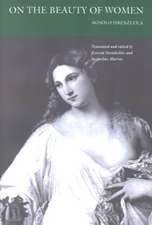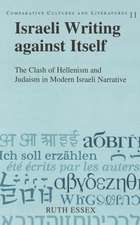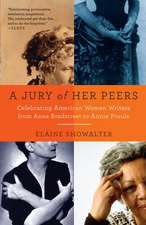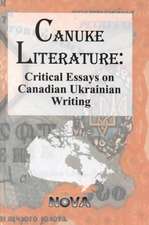Passionate Minds: Women Rewriting the World
Autor Claudia Roth Pierponten Limba Engleză Paperback – 31 ian 2001
Vezi toate premiile Carte premiată
Gertrude Stein, Mae West, Margaret Mitchell, Eudora Welty, Ayn Rand, Doris Lessing, Anais Nin, Zora Neale Hurston, Marina Tsvetaeva, Hannah Arendt and Mary Mccarthy, and Olive Schreiner: Pierpont is clear-eyed in her examination of each member of this varied group, connectng her subjects firmly to the issues of sexual freedom, race, and politics that bound them to their times, even as she exposes the roots of their uniqueness.
"Pierpont['s] graceful essays are at once erudite and personal in their focus." ?The Boston Globe
"One of the most ceaselessly interesting books I've read in some time." ?Lorrie Moore, The New York Review of Books
Preț: 130.19 lei
Nou
Puncte Express: 195
Preț estimativ în valută:
24.92€ • 25.92$ • 20.57£
24.92€ • 25.92$ • 20.57£
Carte disponibilă
Livrare economică 25 martie-08 aprilie
Preluare comenzi: 021 569.72.76
Specificații
ISBN-13: 9780679751137
ISBN-10: 0679751130
Pagini: 320
Ilustrații: 13 PHOTOS
Dimensiuni: 133 x 203 x 17 mm
Greutate: 0.3 kg
Ediția:Vintage Books.
Editura: Vintage Books USA
ISBN-10: 0679751130
Pagini: 320
Ilustrații: 13 PHOTOS
Dimensiuni: 133 x 203 x 17 mm
Greutate: 0.3 kg
Ediția:Vintage Books.
Editura: Vintage Books USA
Recenzii
“One of the most ceaselessly interesting books I’ve read in some time.”–Lorrie Moore, The New York Review of Books
Notă biografică
Claudia Roth Pierpont, a contributor to The New Yorker since 1990, has received a Whiting Writer's Award and a Guggenheim Fellowship. She holds a Ph.D. in Italian Renaissance art history from New York University. She lives in New York City.
From the Hardcover edition.
From the Hardcover edition.
Extras
Introduction
T his book was conceived when two writers who seemed to embody entirely different concerns -- the South African "agnostic" novelist Olive Schreiner and the author of America's champion best-seller, Margaret Mitchell -- turned out to have a great deal in common. Born nearly half a century and half a world apart, both wrote about race and its place in the history of a bitterly divided country, about a time of difficult change from one era to the next, and about women who were too strong to fit into established feminine patterns. And both had an extraordinary effect on readers: in the 1880s, Schreiner's The Story of an African Farm was widely perceived as a spiritual bridge between Darwinian science and the need for God; in the mid-1930s and for a long time after, a significant number of Americans viewed the Civil War and Reconstruction -- with all their implications for the contemporary racial order -- as Mitchell had portrayed them in Gone with the Wind. Whatever the merits of their prose or their arguments, these women told stories that changed the way people thought and lived.
Fascinated by this kind of naïve power -- both Schreiner's and Mitchell's books were first novels -- I began to consider other literary women of influence (very different from women of literary influence) whose domain is somewhat off the usual critical path. The resulting group is emphatically diverse; there is hardly a woman here who would not be scandalized to find herself in company with most of the others. Hannah Arendt and Ayn Rand, Gertrude Stein and Mae West, Doris Lessing and Anaïs Nin, Zora Neale Hurston and Eudora Welty, Marina Tsvetaeva and Mary McCarthy: what could they possibly have in common? Part of the excitement of working with such contrary figures lay in comparing their different versions of absolute truth: the individualism of Rand versus the Communism of Lessing, the ideal of sexual liberation in Mae West versus that of Nin or Lessing or McCarthy, the voice of the American South as heard by Hurston and by Welty. And yet, again, similarities began to emerge, not in what these women wrote but in how they contrived to get it written: that is, in how ambitious women worked out their destinies in an age of momentous transition for their sex, when -- to paraphrase Olive Schreiner on religious faith -- the old ways seemed outworn but new ones had not been invented.
This book is organized into three sections within an overall (if elastic) chronological sequence. Broadly speaking, the first section deals with issues of sexual freedom (Schreiner, Stein, Nin, West), the second with race (Mitchell, Hurston, Welty), and the third with politics -- particularly with the idea and reality of Communism (Tsvetaeva, Rand, Lessing, Arendt and McCarthy). There are, however, many overlapping interests and crossings of category. Marina Tsvetaeva, for example, might easily have been placed within the first group -- for her life's lesson about sexual desire as a driving source of creativity -- but her experience under Stalin offers a valuable check against some of the more theoretical responses to the Soviet state that follow. Mae West may not seem to belong in this book at all, but it is precisely the point that she was, by necessity, a writer as well as a performer; if she hadn't made herself up, characters and plays and scripts and jokes and all, no one would have done it for her. And this process of self-creation is only slightly less true -- less obviously, literally true -- for many of the others. (Can there be two grander, braver, more perversely endearing heroines in twentieth-century fiction than Gertrude Stein and Ayn Rand?)
Certain bases of comparison, then, are obvious: this book is constructed around them. Others appeared only as I went along, and these themes will emerge from story to story: the undermining dangers of ro-mantic love, knowingly avoided or helplessly pursued; the vital, unused energies of an earlier generation of mothers who were strong enough to push (or weak enough to drive) their daughters out into the world; physical beauty as a useful weapon and as a mirror-lined trap; the question of a feminine style in writing, aspired to or despised; the opposition between moral and artistic purpose -- or, as it was often defined, between proper womanly sacrifice and disgracefully unfemale selfishness. There were so many possibilities for error and catastrophe, all so eagerly embraced, and all likely to prompt furious exasperation from today's reader -- along with the affectionate gratitude that these women deserve. For they had hardly any models to follow, apart from a handful of suicidal literary heroines; one of the reasons we can judge so harshly now is because we have had them.
It might reasonably be asked whether this book represents a progress. What are the advances made in the lives and attitudes of women over the course of a century, from Olive Schreiner to Doris Lessing? The rights and advantages that Schreiner fought for -- the votes, the jobs -- have been well established. But what of internal change? That has turned out to be the most difficult subject to grapple with, impossible to summarize because so distinct from life to life. These are, after all, women of a transitional age -- as Schreiner defined it, as Lessing also experienced it, as many women still do. These are lives in which success is hard won, retreat and even breakdown are common, love is difficult, and children are nearly impossible, lives in which all that is ever certain is that books and plays and poems are being written.
From the Hardcover edition.
T his book was conceived when two writers who seemed to embody entirely different concerns -- the South African "agnostic" novelist Olive Schreiner and the author of America's champion best-seller, Margaret Mitchell -- turned out to have a great deal in common. Born nearly half a century and half a world apart, both wrote about race and its place in the history of a bitterly divided country, about a time of difficult change from one era to the next, and about women who were too strong to fit into established feminine patterns. And both had an extraordinary effect on readers: in the 1880s, Schreiner's The Story of an African Farm was widely perceived as a spiritual bridge between Darwinian science and the need for God; in the mid-1930s and for a long time after, a significant number of Americans viewed the Civil War and Reconstruction -- with all their implications for the contemporary racial order -- as Mitchell had portrayed them in Gone with the Wind. Whatever the merits of their prose or their arguments, these women told stories that changed the way people thought and lived.
Fascinated by this kind of naïve power -- both Schreiner's and Mitchell's books were first novels -- I began to consider other literary women of influence (very different from women of literary influence) whose domain is somewhat off the usual critical path. The resulting group is emphatically diverse; there is hardly a woman here who would not be scandalized to find herself in company with most of the others. Hannah Arendt and Ayn Rand, Gertrude Stein and Mae West, Doris Lessing and Anaïs Nin, Zora Neale Hurston and Eudora Welty, Marina Tsvetaeva and Mary McCarthy: what could they possibly have in common? Part of the excitement of working with such contrary figures lay in comparing their different versions of absolute truth: the individualism of Rand versus the Communism of Lessing, the ideal of sexual liberation in Mae West versus that of Nin or Lessing or McCarthy, the voice of the American South as heard by Hurston and by Welty. And yet, again, similarities began to emerge, not in what these women wrote but in how they contrived to get it written: that is, in how ambitious women worked out their destinies in an age of momentous transition for their sex, when -- to paraphrase Olive Schreiner on religious faith -- the old ways seemed outworn but new ones had not been invented.
This book is organized into three sections within an overall (if elastic) chronological sequence. Broadly speaking, the first section deals with issues of sexual freedom (Schreiner, Stein, Nin, West), the second with race (Mitchell, Hurston, Welty), and the third with politics -- particularly with the idea and reality of Communism (Tsvetaeva, Rand, Lessing, Arendt and McCarthy). There are, however, many overlapping interests and crossings of category. Marina Tsvetaeva, for example, might easily have been placed within the first group -- for her life's lesson about sexual desire as a driving source of creativity -- but her experience under Stalin offers a valuable check against some of the more theoretical responses to the Soviet state that follow. Mae West may not seem to belong in this book at all, but it is precisely the point that she was, by necessity, a writer as well as a performer; if she hadn't made herself up, characters and plays and scripts and jokes and all, no one would have done it for her. And this process of self-creation is only slightly less true -- less obviously, literally true -- for many of the others. (Can there be two grander, braver, more perversely endearing heroines in twentieth-century fiction than Gertrude Stein and Ayn Rand?)
Certain bases of comparison, then, are obvious: this book is constructed around them. Others appeared only as I went along, and these themes will emerge from story to story: the undermining dangers of ro-mantic love, knowingly avoided or helplessly pursued; the vital, unused energies of an earlier generation of mothers who were strong enough to push (or weak enough to drive) their daughters out into the world; physical beauty as a useful weapon and as a mirror-lined trap; the question of a feminine style in writing, aspired to or despised; the opposition between moral and artistic purpose -- or, as it was often defined, between proper womanly sacrifice and disgracefully unfemale selfishness. There were so many possibilities for error and catastrophe, all so eagerly embraced, and all likely to prompt furious exasperation from today's reader -- along with the affectionate gratitude that these women deserve. For they had hardly any models to follow, apart from a handful of suicidal literary heroines; one of the reasons we can judge so harshly now is because we have had them.
It might reasonably be asked whether this book represents a progress. What are the advances made in the lives and attitudes of women over the course of a century, from Olive Schreiner to Doris Lessing? The rights and advantages that Schreiner fought for -- the votes, the jobs -- have been well established. But what of internal change? That has turned out to be the most difficult subject to grapple with, impossible to summarize because so distinct from life to life. These are, after all, women of a transitional age -- as Schreiner defined it, as Lessing also experienced it, as many women still do. These are lives in which success is hard won, retreat and even breakdown are common, love is difficult, and children are nearly impossible, lives in which all that is ever certain is that books and plays and poems are being written.
From the Hardcover edition.
Premii
- National Book Critics Circle Award Nominee, 2000
